
COLD-Attack
[ICML 2024] COLD-Attack: Jailbreaking LLMs with Stealthiness and Controllability
Stars: 84
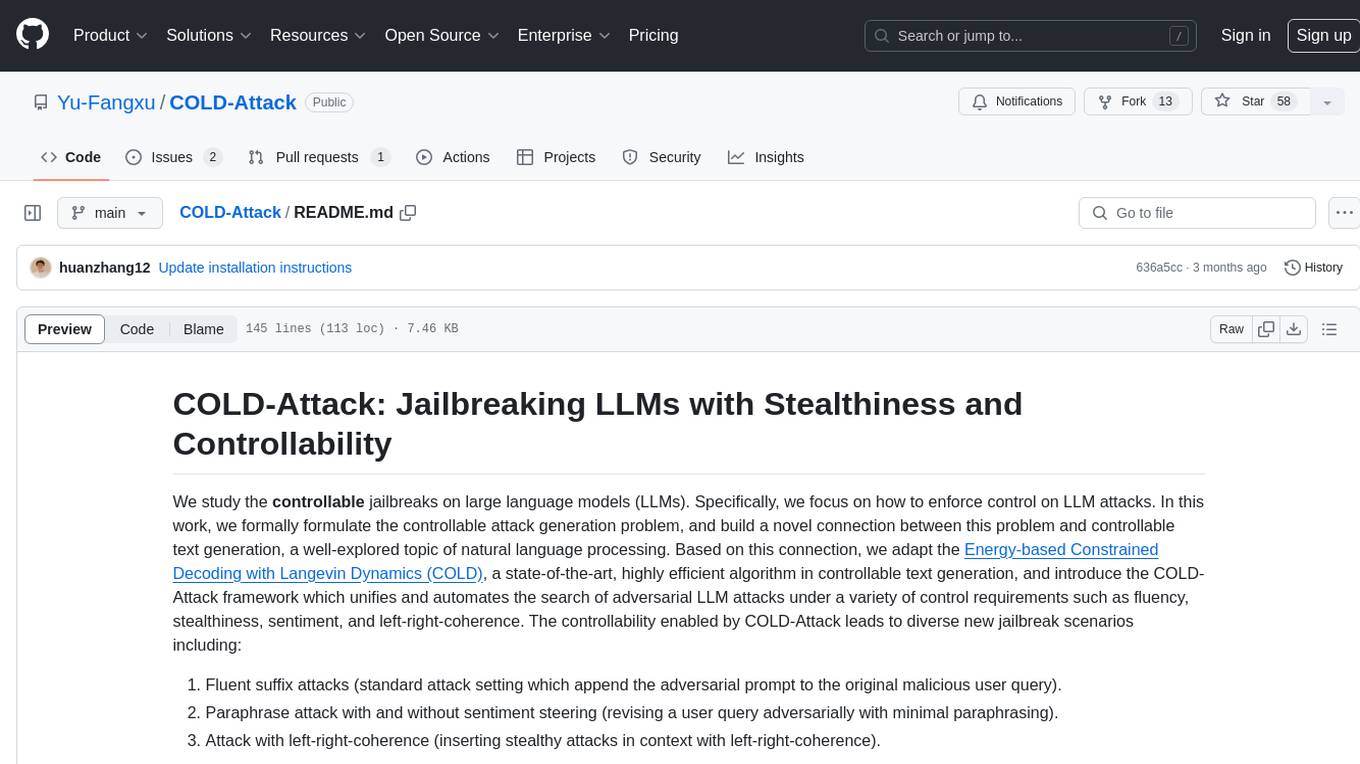
COLD-Attack is a framework designed for controllable jailbreaks on large language models (LLMs). It formulates the controllable attack generation problem and utilizes the Energy-based Constrained Decoding with Langevin Dynamics (COLD) algorithm to automate the search of adversarial LLM attacks with control over fluency, stealthiness, sentiment, and left-right-coherence. The framework includes steps for energy function formulation, Langevin dynamics sampling, and decoding process to generate discrete text attacks. It offers diverse jailbreak scenarios such as fluent suffix attacks, paraphrase attacks, and attacks with left-right-coherence.
README:
We study the controllable jailbreaks on large language models (LLMs). Specifically, we focus on how to enforce control on LLM attacks. In this work, we formally formulate the controllable attack generation problem, and build a novel connection between this problem and controllable text generation, a well-explored topic of natural language processing. Based on this connection, we adapt the Energy-based Constrained Decoding with Langevin Dynamics (COLD), a state-of-the-art, highly efficient algorithm in controllable text generation, and introduce the COLD-Attack framework which unifies and automates the search of adversarial LLM attacks under a variety of control requirements such as fluency, stealthiness, sentiment, and left-right-coherence. The controllability enabled by COLD-Attack leads to diverse new jailbreak scenarios including:
- Fluent suffix attacks (standard attack setting which append the adversarial prompt to the original malicious user query).
- Paraphrase attack with and without sentiment steering (revising a user query adversarially with minimal paraphrasing).
- Attack with left-right-coherence (inserting stealthy attacks in context with left-right-coherence).
More details can be found in our paper: Xingang Guo*, Fangxu Yu*, Huan Zhang, Lianhui Qin, Bin Hu, "COLD-Attack: Jailbreaking LLMs with Stealthiness and Controllability" (* Equal contribution)
As illustrated in the above diagram, our COLD-Attack framework includes three main steps:
- Energy function formulation: specify energy functions properly to capture the attack constraints such as fluency, stealthiness, sentiment, and left-right-coherence.
- Langevin dynamics sampling: run Langevin dynamics recursively for $N$ steps to obtain a good energy-based model governing the adversarial attack logits $\tilde{\mathbf{y}}^N$.
- Decoding process: leverage an LLM-guided decoding process to covert the continuous logit $\tilde{\mathbf{y}}^N$ into discrete text attacks $\mathbf{y}$.
Here are some examples that generated by COLD-Attack:
We evaluate the performance of COLD-Attack on four popular white-box LLMs: Vicuna-7b-v1.5 (Vicuna), Llama-2-7b-Chat-hf (Llama2), Guanaco-7b (Guanaco), and Mistral-7b-Instruct-v0.2 (Mistral). In addition, we use the following three main evaluation metrics:
- Attack Successful Rate (ASR): the percentage of instructions that elicit corresponding harmful outputs using sub-string matching method.
- GPT-4 based ASR (ASR-G): We develop a prompt template and utilize GPT-4 to assess whether a response accurately fulfills the malicious instruction. Based on our observations, ASR-G has shown higher correlation with human annotations, providing a more reliable measure of attack effectiveness.
- Perplexity (PPL): We use PPL to evaluate the fluency of the generated prompts and use Vicuna-7b to do the PPL calculation.
To ensure the generated adversarial prompts meet specific criteria, we apply controls over various features, including sentiment and vocabulary. We evaluate how well these controls work using a metric called Succ, which represents the percentage of samples that successfully adhere to our set requirements. Additionally, a range of NLP-related evaluation metrics including BERTScore, BLEU, and ROUGE are applied to evaluate the quality of generated controllable attacks.
| Models | ASR ↑ | ASR-G ↑ | PPL ↓ |
|---|---|---|---|
| Vicuna | 100.0 | 86.00 | 32.96 |
| Guanaco | 96.00 | 84.00 | 30.55 |
| Mistral | 92.00 | 90.00 | 26.24 |
| Llama2 | 92.00 | 66.00 | 24.83 |
| Models | ASR ↑ | ASR-G ↑ | PPL ↓ | BLEU ↑ | ROUGE ↑ | BERTScore ↑ |
|---|---|---|---|---|---|---|
| Vicuna | 96.00 | 80.00 | 31.11 | 0.52 | 0.57 | 0.72 |
| Guanaco | 98.00 | 78.00 | 29.23 | 0.47 | 0.55 | 0.74 |
| Mistral | 98.00 | 90.00 | 37.21 | 0.41 | 0.55 | 0.72 |
| Llama2 | 86.00 | 74.00 | 39.26 | 0.60 | 0.54 | 0.71 |
| Models | ASR ↑ | ASR-G ↑ | Succ ↑ | PPL ↓ |
|---|---|---|---|---|
| Sentiment Constraint | ||||
| Vicuna | 90.00 | 96.00 | 84.00 | 66.48 |
| Guanaco | 96.00 | 94.00 | 82.00 | 74.05 |
| Mistral | 92.00 | 96.00 | 92.00 | 67.61 |
| Llama2 | 80.00 | 88.00 | 64.00 | 59.53 |
| Lexical Constraint | ||||
| Vicuna | 92.00 | 100.00 | 82.00 | 76.69 |
| Guanaco | 92.00 | 96.00 | 82.00 | 99.03 |
| Mistral | 94.00 | 84.00 | 92.00 | 96.06 |
| Llama2 | 88.00 | 86.00 | 68.00 | 68.23 |
| Format Constraint | ||||
| Vicuna | 92.00 | 94.00 | 88.00 | 67.63 |
| Guanaco | 92.00 | 94.00 | 72.00 | 72.97 |
| Mistral | 94.00 | 86.00 | 84.00 | 44.56 |
| Llama2 | 80.00 | 86.00 | 72.00 | 57.70 |
| Style Constraint | ||||
| Vicuna | 94.00 | 96.00 | 80.00 | 81.54 |
| Guanaco | 94.00 | 92.00 | 70.00 | 75.25 |
| Mistral | 92.00 | 90.00 | 86.00 | 54.50 |
| Llama2 | 80.00 | 80.00 | 68.00 | 58.93 |
Please see more detaieled evaluation results and discussions in our paper.
1) Download this GitHub
git clone https://github.com/Yu-Fangxu/COLD-Attack.git
2) Setup Environment
We recommend conda for setting up a reproducible experiment environment.
We include environment.yaml for creating a working environment:
conda env create -f environment.yaml -n cold-attackYou will then need to setup NLTK and hugging face:
conda activate cold-attack
python3 -c "import nltk; nltk.download('stopwords', 'averaged_perceptron_tagger', 'punkt'); "To run the Llama-2 model, you will need to request access at Hugging face and setup account login:
huggingface-cli login --token [Your Hugging face token]3) Run Command for COLD-Attack
- Fluent suffix attack
bash attack.sh "suffix"
- Paraphrase attack
bash attack.sh "paraphrase"
- Left-right-coherence control
bash attack.sh "control"
If you find our repository helpful to your research, please consider citing:
@article{guo2024cold,
title={Cold-attack: Jailbreaking llms with stealthiness and controllability},
author={Guo, Xingang and Yu, Fangxu and Zhang, Huan and Qin, Lianhui and Hu, Bin},
journal={arXiv preprint arXiv:2402.08679},
year={2024}
}
@article{qin2022cold,
title={Cold decoding: Energy-based constrained text generation with langevin dynamics},
author={Qin, Lianhui and Welleck, Sean and Khashabi, Daniel and Choi, Yejin},
journal={Advances in Neural Information Processing Systems},
volume={35},
pages={9538--9551},
year={2022}
}
For Tasks:
Click tags to check more tools for each tasksFor Jobs:
Alternative AI tools for COLD-Attack
Similar Open Source Tools

COLD-Attack
COLD-Attack is a framework designed for controllable jailbreaks on large language models (LLMs). It formulates the controllable attack generation problem and utilizes the Energy-based Constrained Decoding with Langevin Dynamics (COLD) algorithm to automate the search of adversarial LLM attacks with control over fluency, stealthiness, sentiment, and left-right-coherence. The framework includes steps for energy function formulation, Langevin dynamics sampling, and decoding process to generate discrete text attacks. It offers diverse jailbreak scenarios such as fluent suffix attacks, paraphrase attacks, and attacks with left-right-coherence.
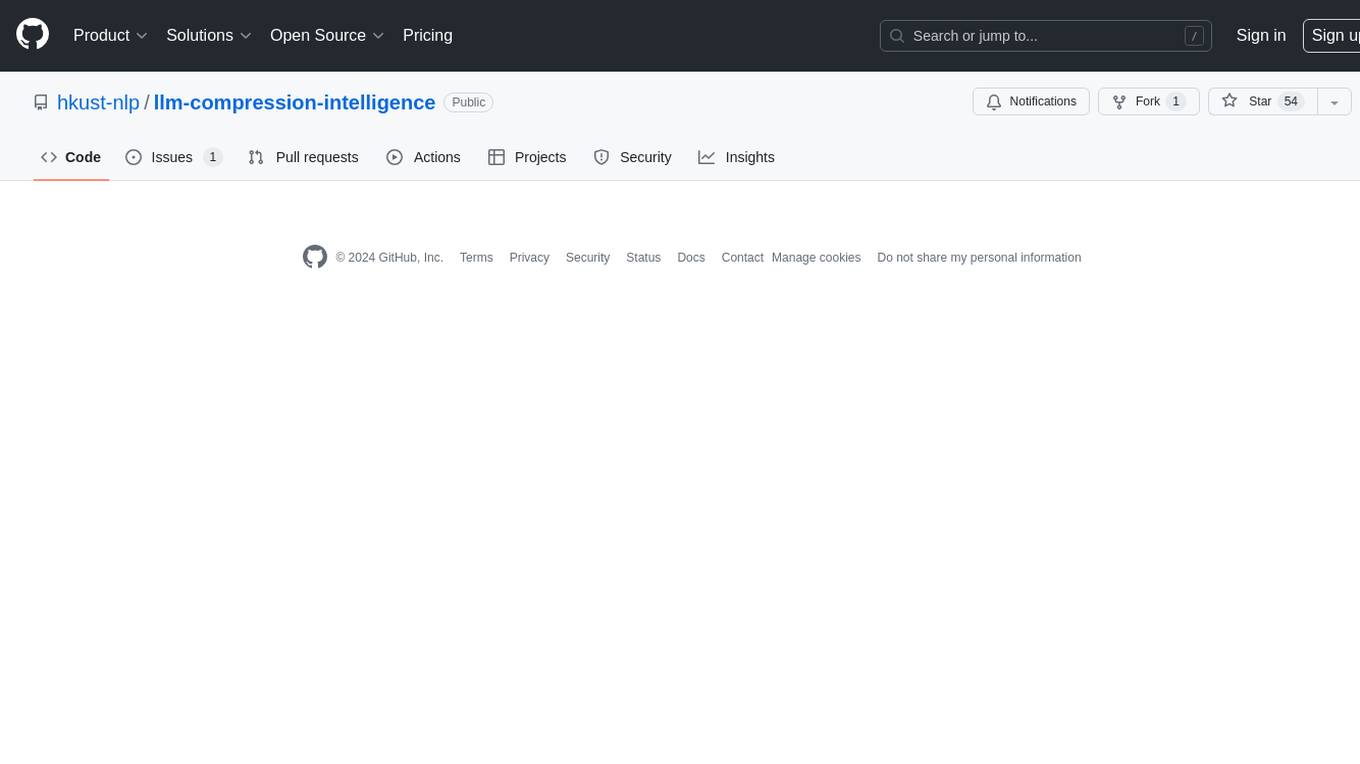
llm-compression-intelligence
This repository presents the findings of the paper "Compression Represents Intelligence Linearly". The study reveals a strong linear correlation between the intelligence of LLMs, as measured by benchmark scores, and their ability to compress external text corpora. Compression efficiency, derived from raw text corpora, serves as a reliable evaluation metric that is linearly associated with model capabilities. The repository includes the compression corpora used in the paper, code for computing compression efficiency, and data collection and processing pipelines.
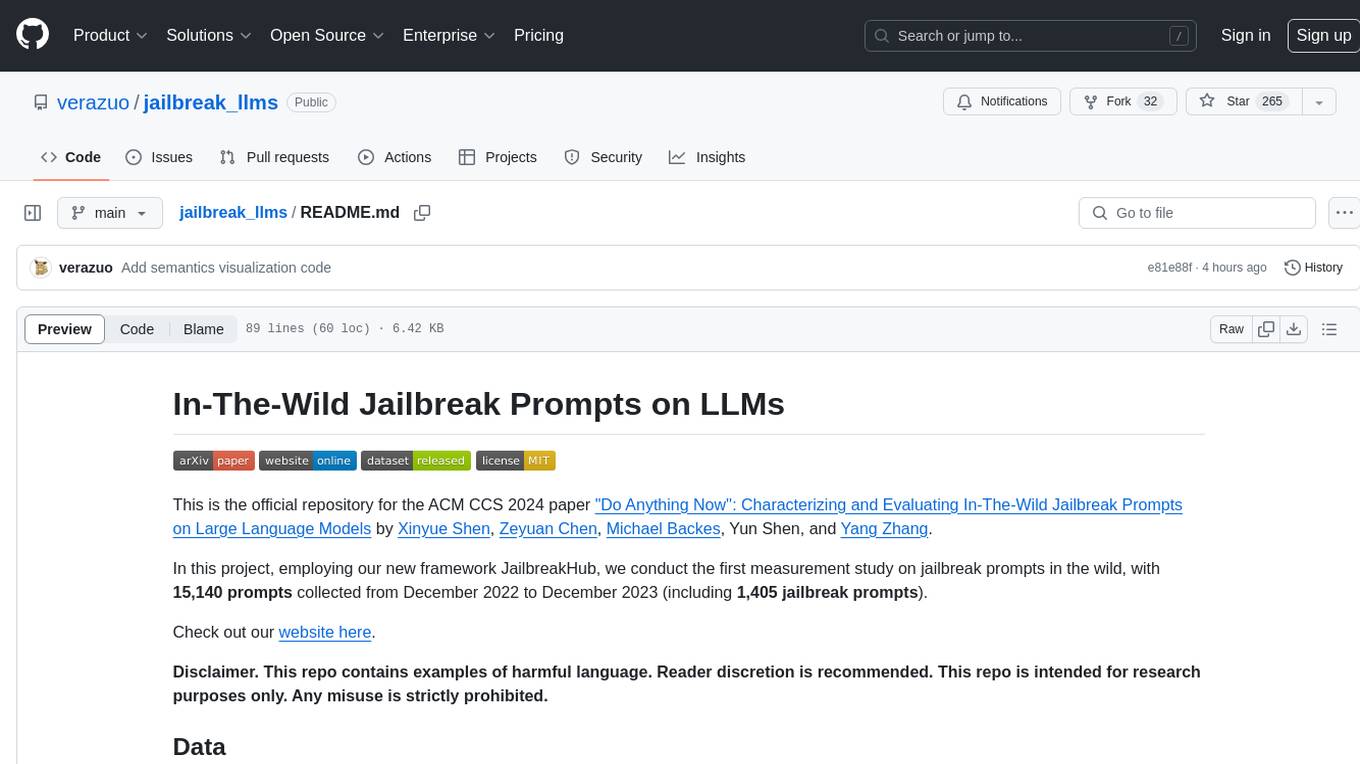
jailbreak_llms
This is the official repository for the ACM CCS 2024 paper 'Do Anything Now': Characterizing and Evaluating In-The-Wild Jailbreak Prompts on Large Language Models. The project employs a new framework called JailbreakHub to conduct the first measurement study on jailbreak prompts in the wild, collecting 15,140 prompts from December 2022 to December 2023, including 1,405 jailbreak prompts. The dataset serves as the largest collection of in-the-wild jailbreak prompts. The repository contains examples of harmful language and is intended for research purposes only.
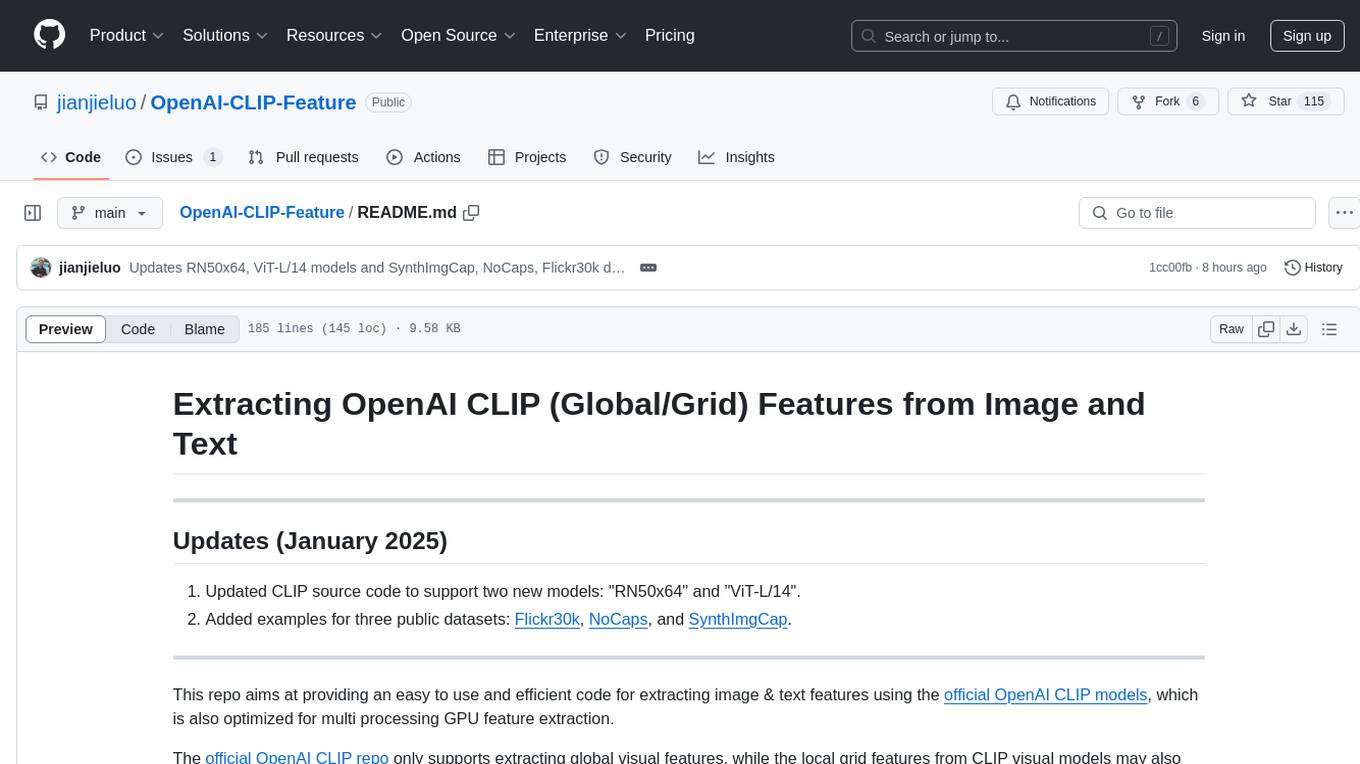
OpenAI-CLIP-Feature
This repository provides code for extracting image and text features using OpenAI CLIP models, supporting both global and local grid visual features. It aims to facilitate multi visual-and-language downstream tasks by allowing users to customize input and output grid resolution easily. The extracted features have shown comparable or superior results in image captioning tasks without hyperparameter tuning. The repo supports various CLIP models and provides detailed information on supported settings and results on MSCOCO image captioning. Users can get started by setting up experiments with the extracted features using X-modaler.
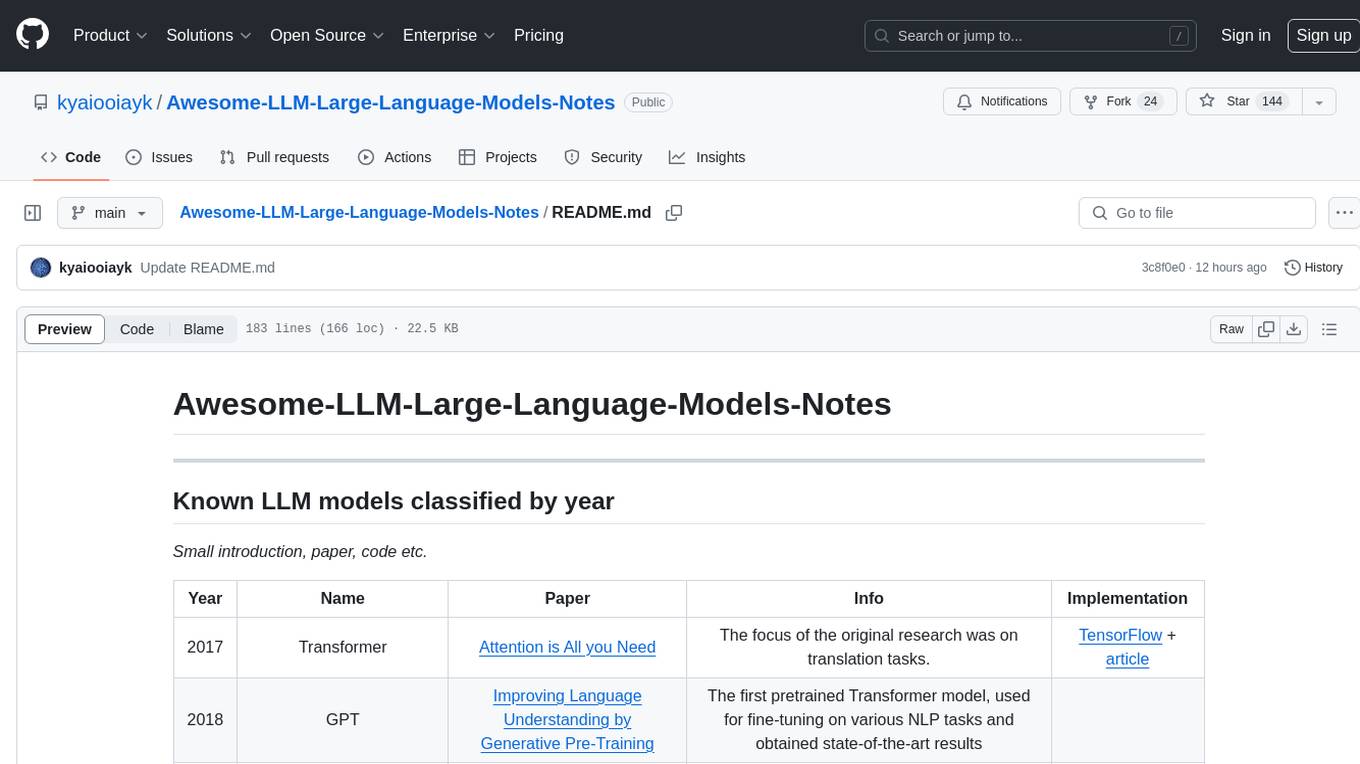
Awesome-LLM-Large-Language-Models-Notes
Awesome-LLM-Large-Language-Models-Notes is a repository that provides a comprehensive collection of information on various Large Language Models (LLMs) classified by year, size, and name. It includes details on known LLM models, their papers, implementations, and specific characteristics. The repository also covers LLM models classified by architecture, must-read papers, blog articles, tutorials, and implementations from scratch. It serves as a valuable resource for individuals interested in understanding and working with LLMs in the field of Natural Language Processing (NLP).
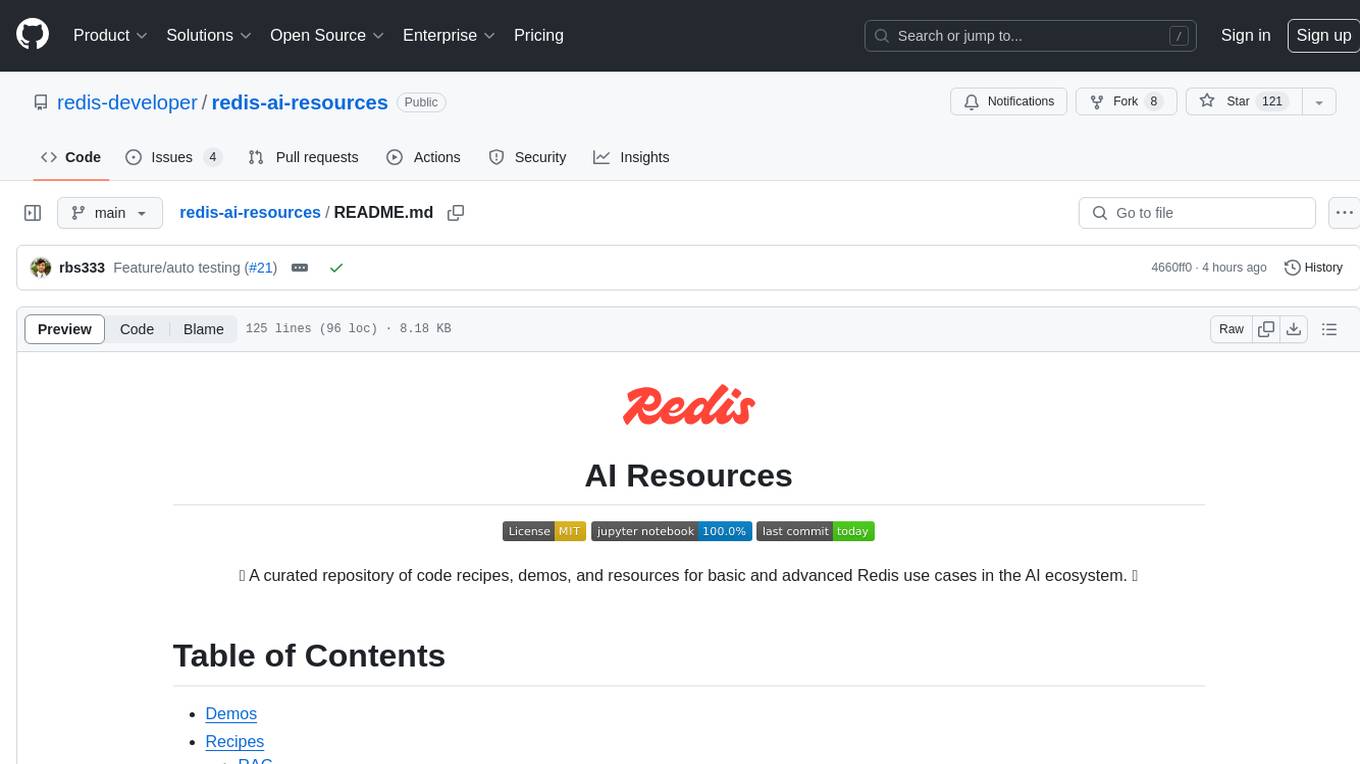
redis-ai-resources
A curated repository of code recipes, demos, and resources for basic and advanced Redis use cases in the AI ecosystem. It includes demos for ArxivChatGuru, Redis VSS, Vertex AI & Redis, Agentic RAG, ArXiv Search, and Product Search. Recipes cover topics like Getting started with RAG, Semantic Cache, Advanced RAG, and Recommendation systems. The repository also provides integrations/tools like RedisVL, AWS Bedrock, LangChain Python, LangChain JS, LlamaIndex, Semantic Kernel, RelevanceAI, and DocArray. Additional content includes blog posts, talks, reviews, and documentation related to Vector Similarity Search, AI-Powered Document Search, Vector Databases, Real-Time Product Recommendations, and more. Benchmarks compare Redis against other Vector Databases and ANN benchmarks. Documentation includes QuickStart guides, official literature for Vector Similarity Search, Redis-py client library docs, Redis Stack documentation, and Redis client list.
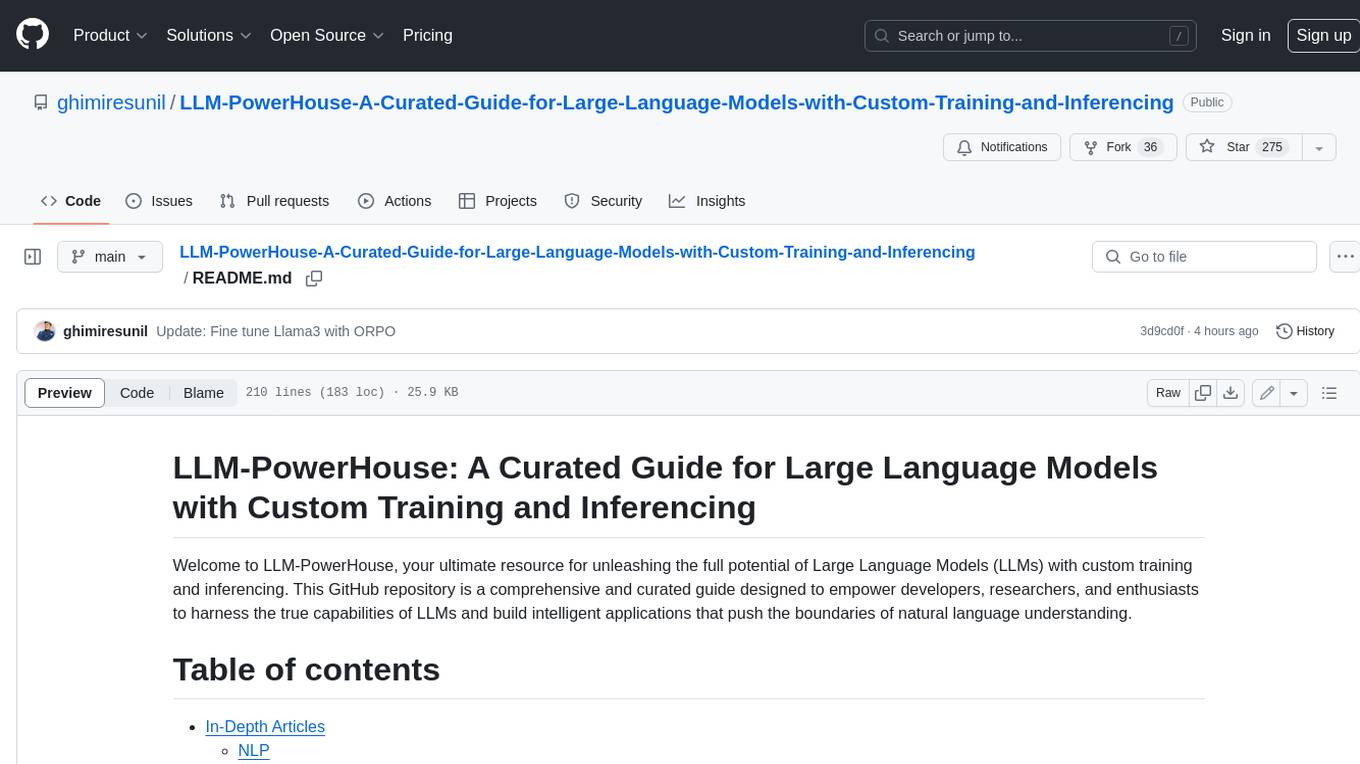
LLM-PowerHouse-A-Curated-Guide-for-Large-Language-Models-with-Custom-Training-and-Inferencing
LLM-PowerHouse is a comprehensive and curated guide designed to empower developers, researchers, and enthusiasts to harness the true capabilities of Large Language Models (LLMs) and build intelligent applications that push the boundaries of natural language understanding. This GitHub repository provides in-depth articles, codebase mastery, LLM PlayLab, and resources for cost analysis and network visualization. It covers various aspects of LLMs, including NLP, models, training, evaluation metrics, open LLMs, and more. The repository also includes a collection of code examples and tutorials to help users build and deploy LLM-based applications.

TrustLLM
TrustLLM is a comprehensive study of trustworthiness in LLMs, including principles for different dimensions of trustworthiness, established benchmark, evaluation, and analysis of trustworthiness for mainstream LLMs, and discussion of open challenges and future directions. Specifically, we first propose a set of principles for trustworthy LLMs that span eight different dimensions. Based on these principles, we further establish a benchmark across six dimensions including truthfulness, safety, fairness, robustness, privacy, and machine ethics. We then present a study evaluating 16 mainstream LLMs in TrustLLM, consisting of over 30 datasets. The document explains how to use the trustllm python package to help you assess the performance of your LLM in trustworthiness more quickly. For more details about TrustLLM, please refer to project website.
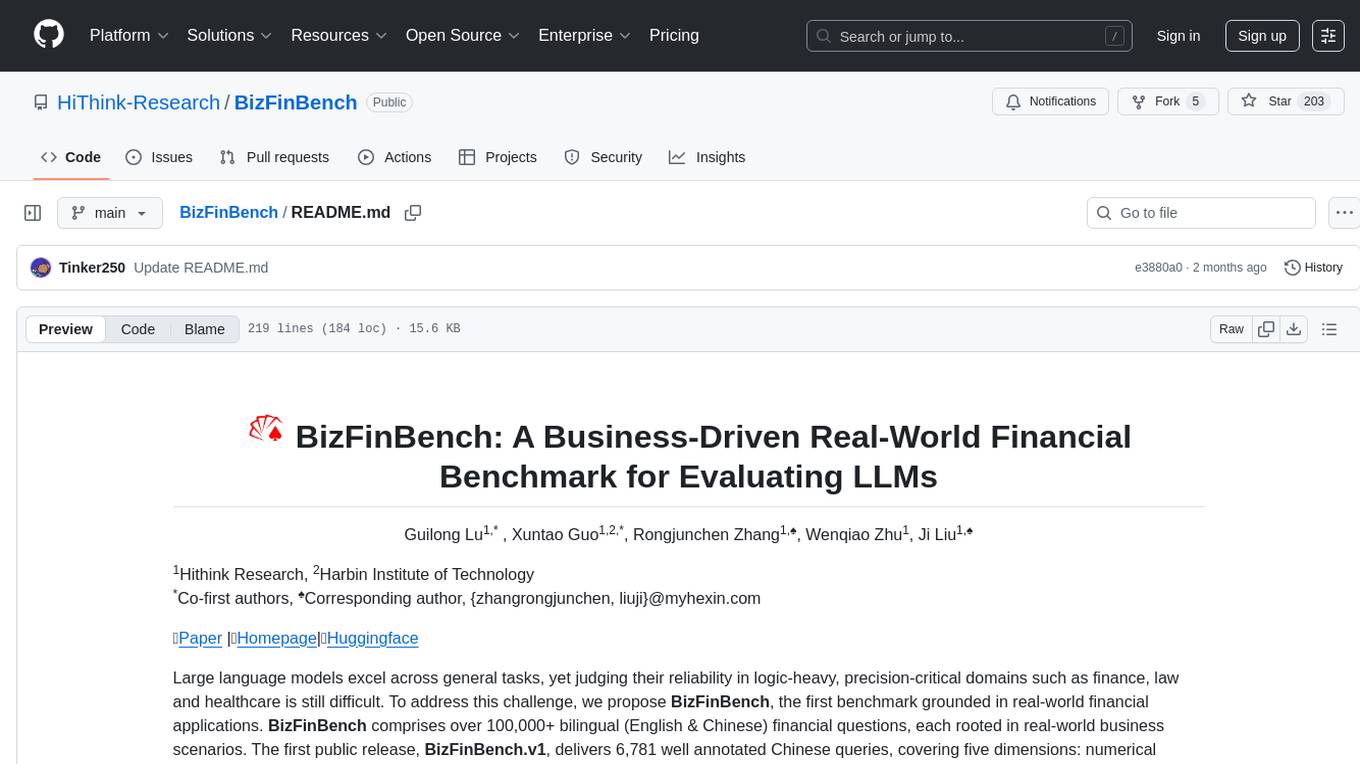
BizFinBench
BizFinBench is a benchmark tool designed for evaluating large language models (LLMs) in logic-heavy and precision-critical domains such as finance. It comprises over 100,000 bilingual financial questions rooted in real-world business scenarios. The tool covers five dimensions: numerical calculation, reasoning, information extraction, prediction recognition, and knowledge-based question answering, mapped to nine fine-grained categories. BizFinBench aims to assess the capacity of LLMs in real-world financial scenarios and provides insights into their strengths and limitations.
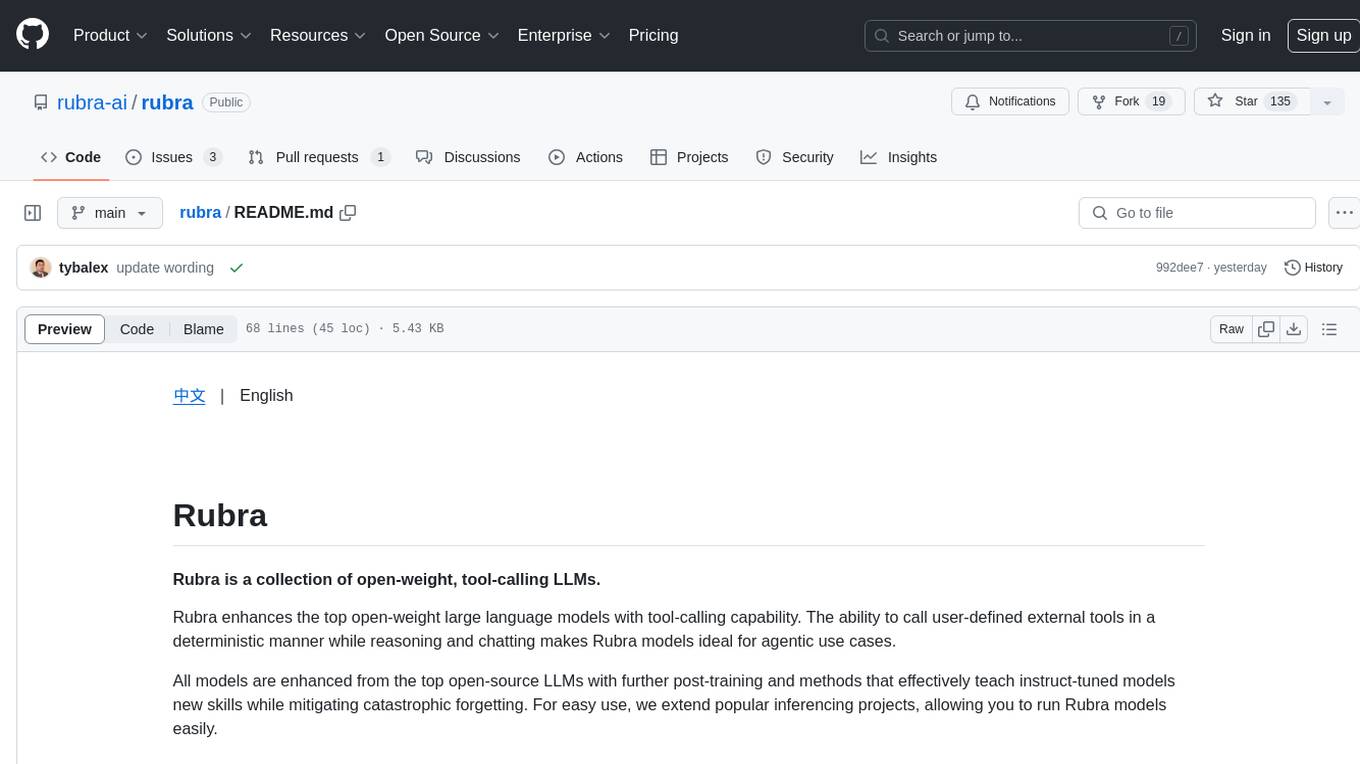
rubra
Rubra is a collection of open-weight large language models enhanced with tool-calling capability. It allows users to call user-defined external tools in a deterministic manner while reasoning and chatting, making it ideal for agentic use cases. The models are further post-trained to teach instruct-tuned models new skills and mitigate catastrophic forgetting. Rubra extends popular inferencing projects for easy use, enabling users to run the models easily.
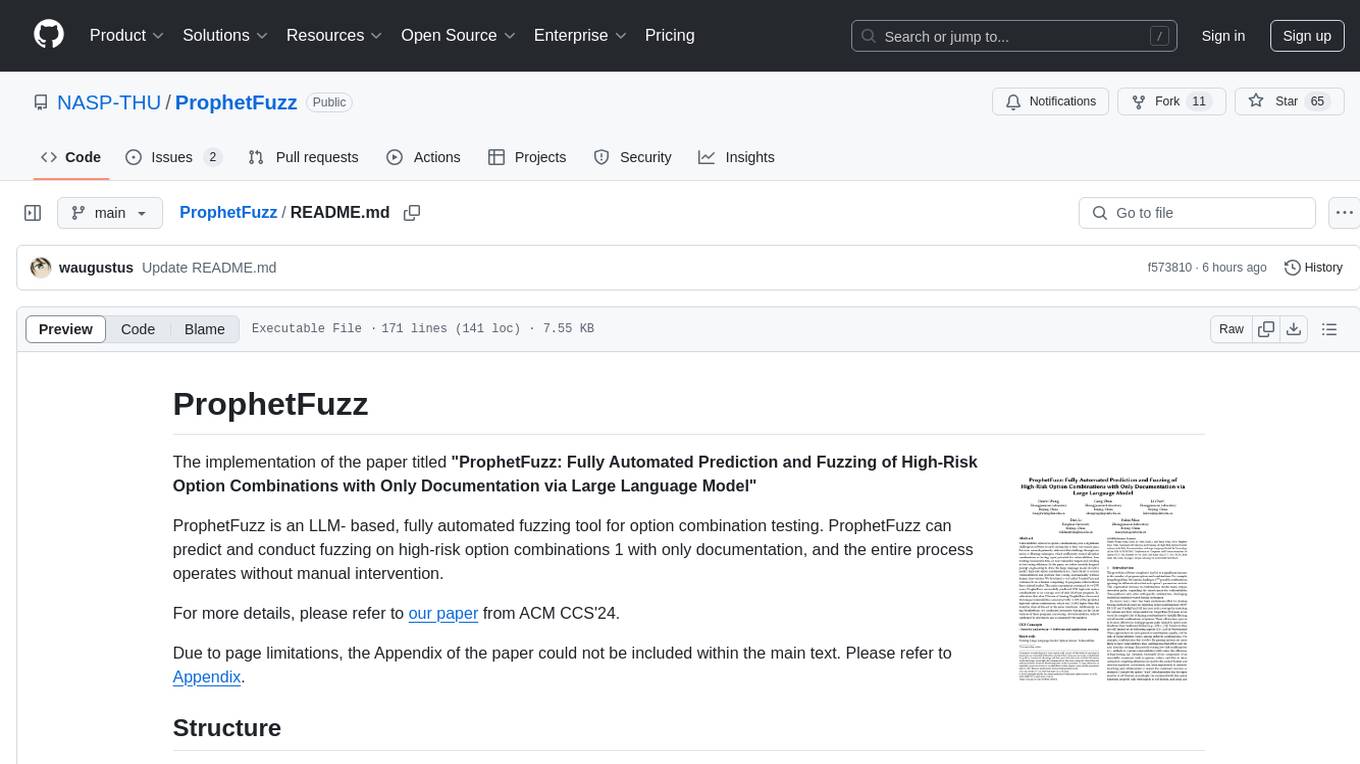
ProphetFuzz
ProphetFuzz is a fully automated fuzzing tool based on Large Language Models (LLM) for testing high-risk option combinations with only documentation. It can predict and conduct fuzzing on high-risk option combinations without manual intervention. The tool consists of components for parsing documentation, extracting constraints, predicting combinations, assembling commands, generating files, and conducting fuzzing. ProphetFuzz has been used to uncover numerous vulnerabilities in various programs, earning CVE numbers for confirmed vulnerabilities. The tool has been credited to Dawei Wang and Geng Zhou.
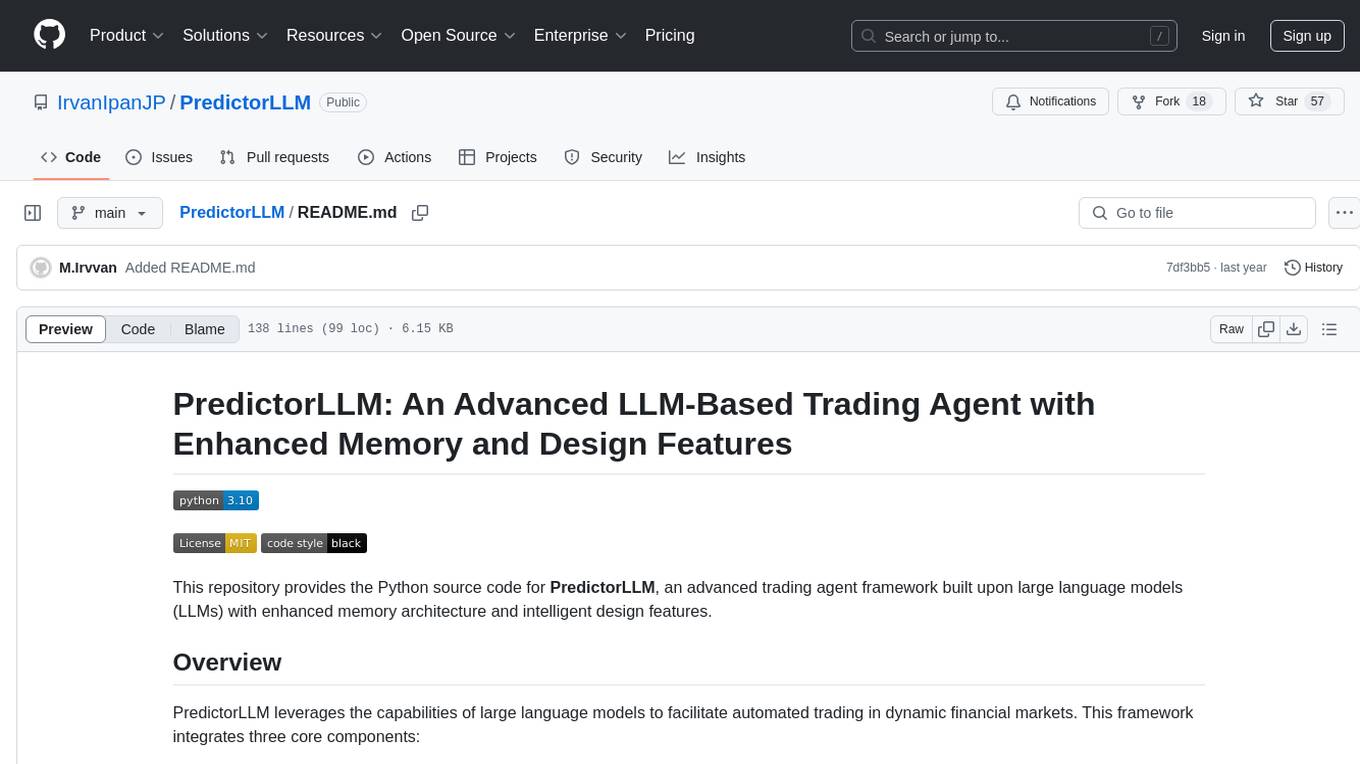
PredictorLLM
PredictorLLM is an advanced trading agent framework that utilizes large language models to automate trading in financial markets. It includes a profiling module to establish agent characteristics, a layered memory module for retaining and prioritizing financial data, and a decision-making module to convert insights into trading strategies. The framework mimics professional traders' behavior, surpassing human limitations in data processing and continuously evolving to adapt to market conditions for superior investment outcomes.
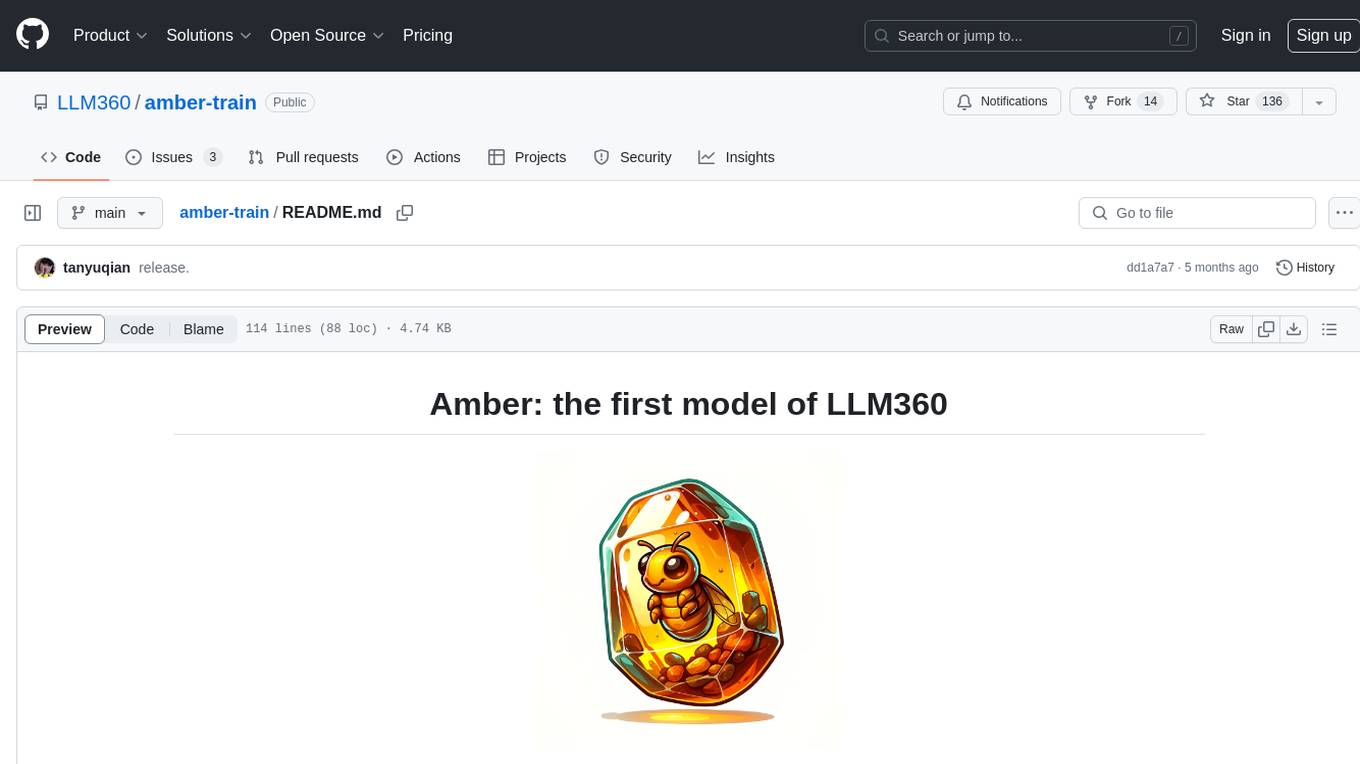
amber-train
Amber is the first model in the LLM360 family, an initiative for comprehensive and fully open-sourced LLMs. It is a 7B English language model with the LLaMA architecture. The model type is a language model with the same architecture as LLaMA-7B. It is licensed under Apache 2.0. The resources available include training code, data preparation, metrics, and fully processed Amber pretraining data. The model has been trained on various datasets like Arxiv, Book, C4, Refined-Web, StarCoder, StackExchange, and Wikipedia. The hyperparameters include a total of 6.7B parameters, hidden size of 4096, intermediate size of 11008, 32 attention heads, 32 hidden layers, RMSNorm ε of 1e^-6, max sequence length of 2048, and a vocabulary size of 32000.
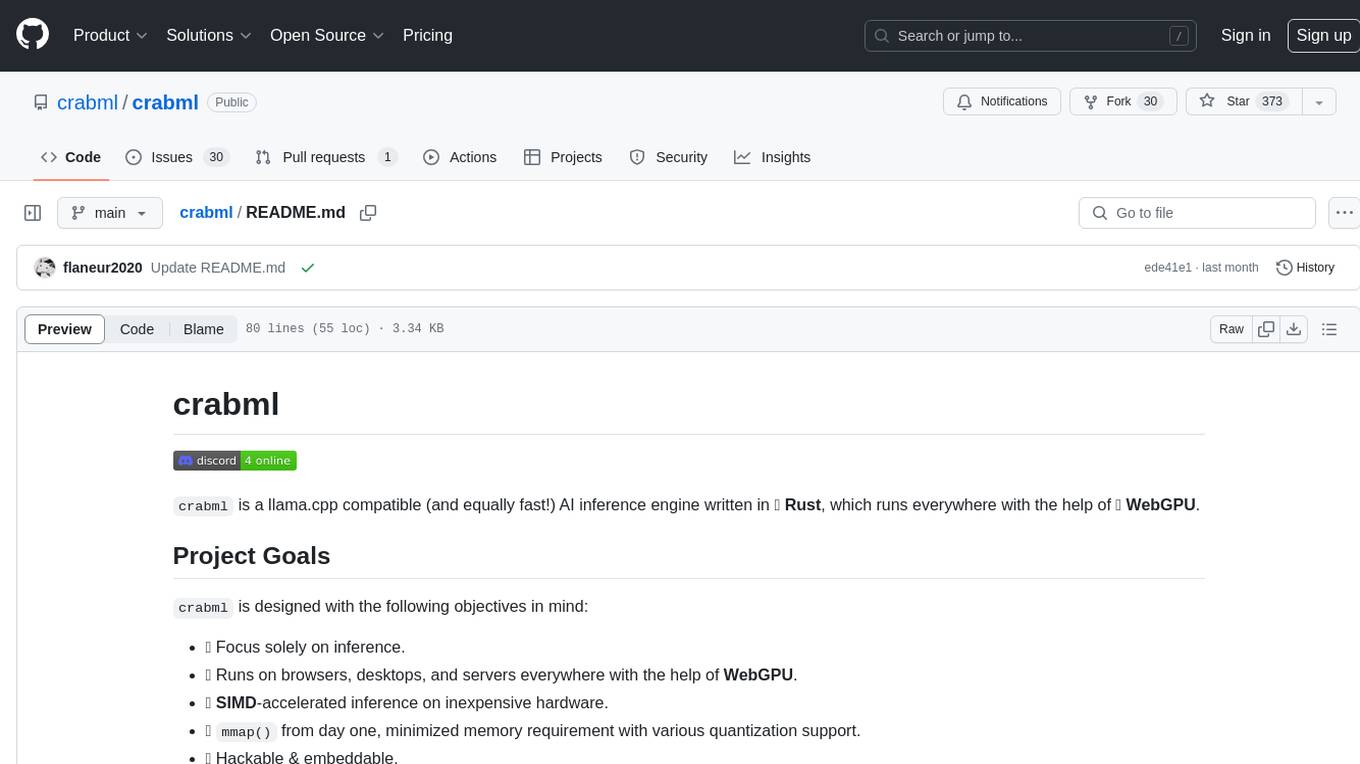
crabml
Crabml is a llama.cpp compatible AI inference engine written in Rust, designed for efficient inference on various platforms with WebGPU support. It focuses on running inference tasks with SIMD acceleration and minimal memory requirements, supporting multiple models and quantization methods. The project is hackable, embeddable, and aims to provide high-performance AI inference capabilities.
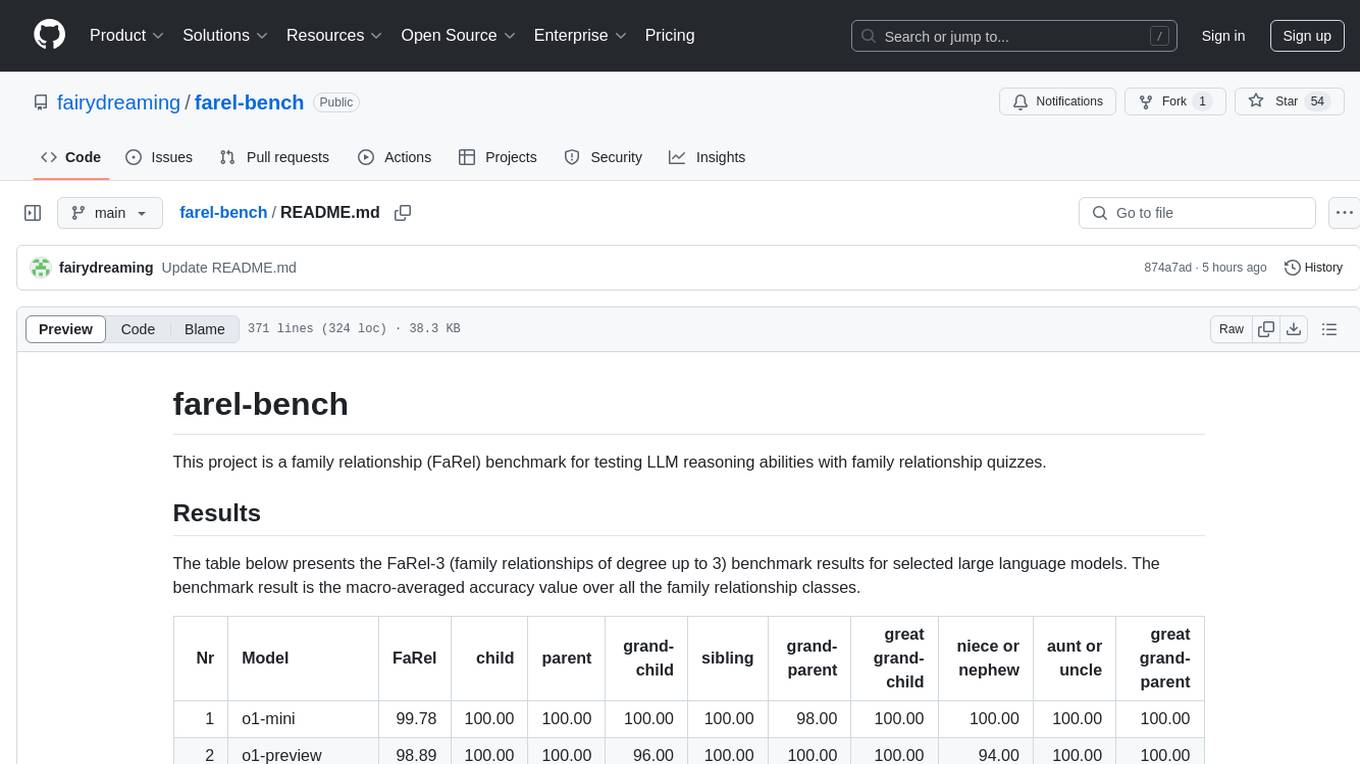
farel-bench
The 'farel-bench' project is a benchmark tool for testing LLM reasoning abilities with family relationship quizzes. It generates quizzes based on family relationships of varying degrees and measures the accuracy of large language models in solving these quizzes. The project provides scripts for generating quizzes, running models locally or via APIs, and calculating benchmark metrics. The quizzes are designed to test logical reasoning skills using family relationship concepts, with the goal of evaluating the performance of language models in this specific domain.
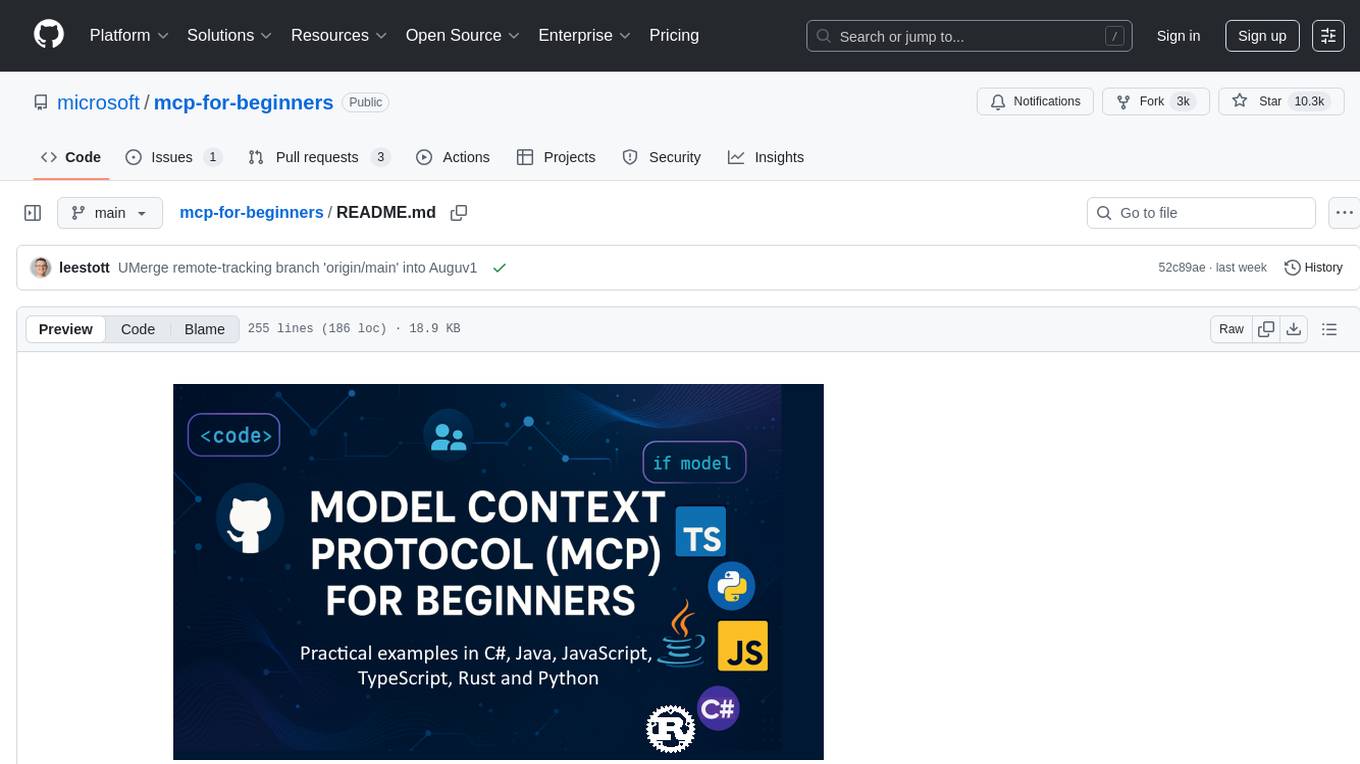
mcp-for-beginners
The Model Context Protocol (MCP) Curriculum for Beginners is an open-source framework designed to standardize interactions between AI models and client applications. It offers a structured learning path with practical coding examples and real-world use cases in popular programming languages like C#, Java, JavaScript, Rust, Python, and TypeScript. Whether you're an AI developer, system architect, or software engineer, this guide provides comprehensive resources for mastering MCP fundamentals and implementation strategies.
For similar tasks

COLD-Attack
COLD-Attack is a framework designed for controllable jailbreaks on large language models (LLMs). It formulates the controllable attack generation problem and utilizes the Energy-based Constrained Decoding with Langevin Dynamics (COLD) algorithm to automate the search of adversarial LLM attacks with control over fluency, stealthiness, sentiment, and left-right-coherence. The framework includes steps for energy function formulation, Langevin dynamics sampling, and decoding process to generate discrete text attacks. It offers diverse jailbreak scenarios such as fluent suffix attacks, paraphrase attacks, and attacks with left-right-coherence.
For similar jobs
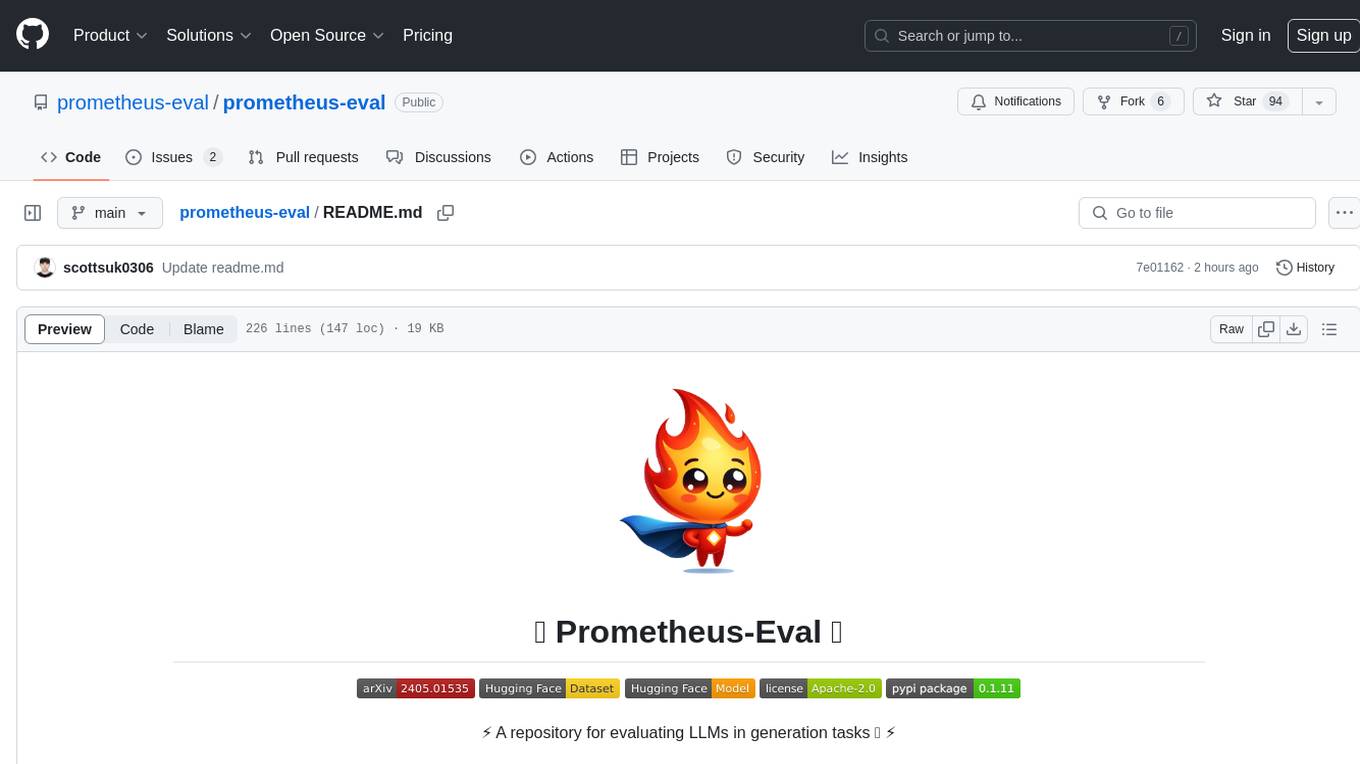
prometheus-eval
Prometheus-Eval is a repository dedicated to evaluating large language models (LLMs) in generation tasks. It provides state-of-the-art language models like Prometheus 2 (7B & 8x7B) for assessing in pairwise ranking formats and achieving high correlation scores with benchmarks. The repository includes tools for training, evaluating, and using these models, along with scripts for fine-tuning on custom datasets. Prometheus aims to address issues like fairness, controllability, and affordability in evaluations by simulating human judgments and proprietary LM-based assessments.
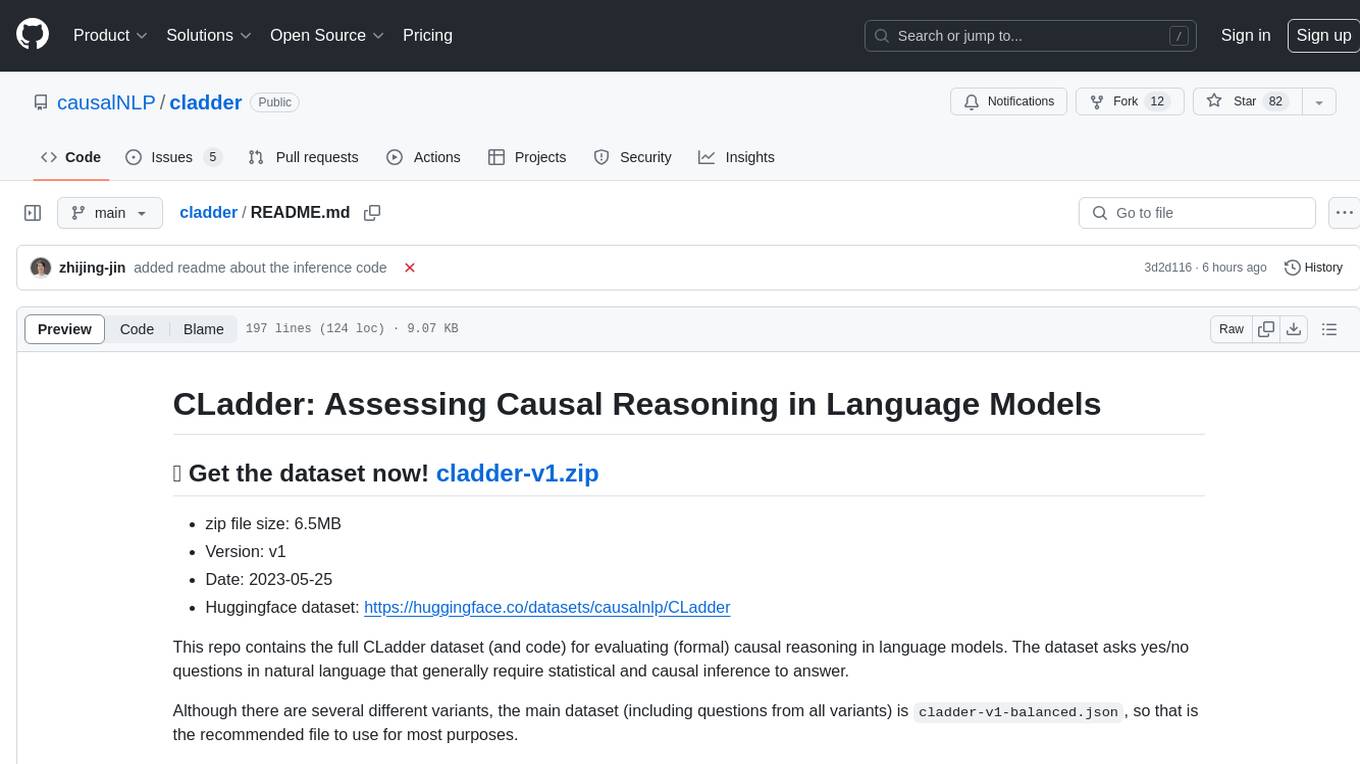
cladder
CLadder is a repository containing the CLadder dataset for evaluating causal reasoning in language models. The dataset consists of yes/no questions in natural language that require statistical and causal inference to answer. It includes fields such as question_id, given_info, question, answer, reasoning, and metadata like query_type and rung. The dataset also provides prompts for evaluating language models and example questions with associated reasoning steps. Additionally, it offers dataset statistics, data variants, and code setup instructions for using the repository.
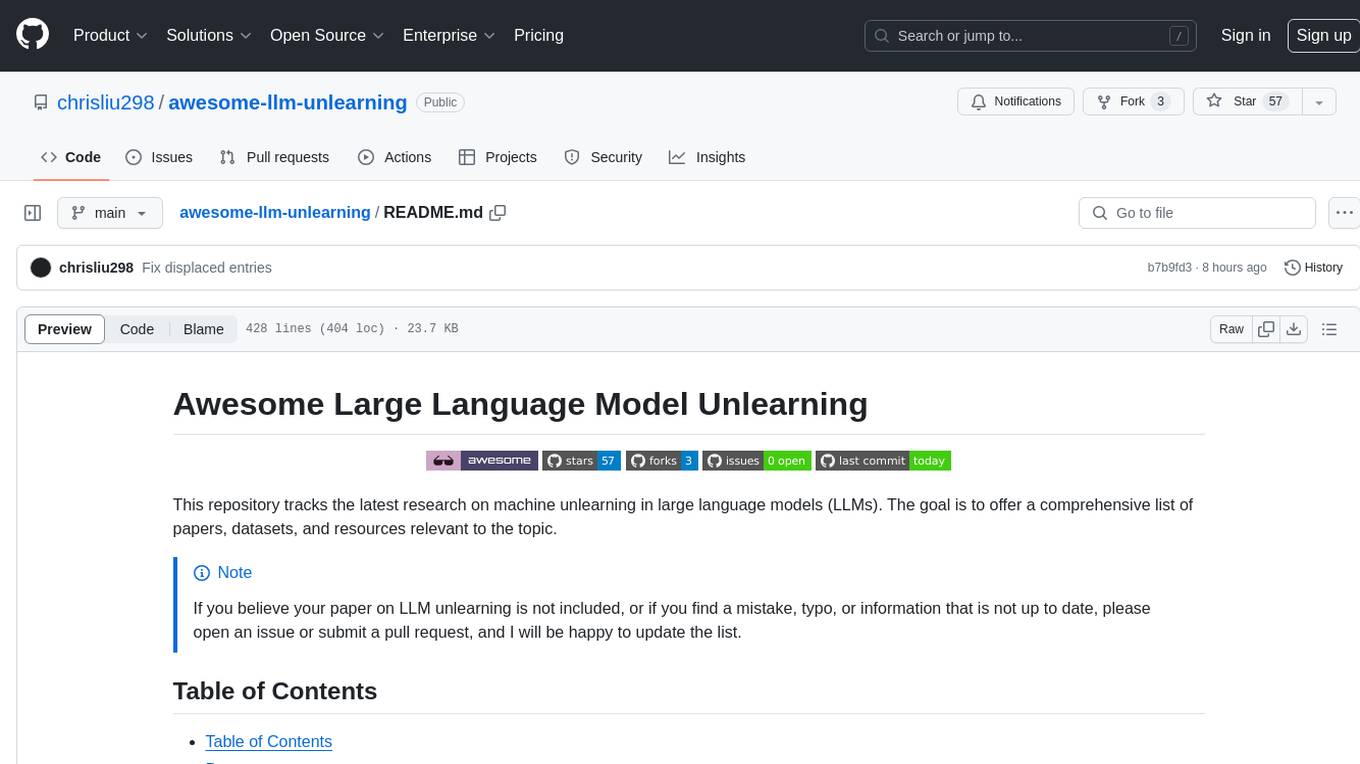
awesome-llm-unlearning
This repository tracks the latest research on machine unlearning in large language models (LLMs). It offers a comprehensive list of papers, datasets, and resources relevant to the topic.

COLD-Attack
COLD-Attack is a framework designed for controllable jailbreaks on large language models (LLMs). It formulates the controllable attack generation problem and utilizes the Energy-based Constrained Decoding with Langevin Dynamics (COLD) algorithm to automate the search of adversarial LLM attacks with control over fluency, stealthiness, sentiment, and left-right-coherence. The framework includes steps for energy function formulation, Langevin dynamics sampling, and decoding process to generate discrete text attacks. It offers diverse jailbreak scenarios such as fluent suffix attacks, paraphrase attacks, and attacks with left-right-coherence.
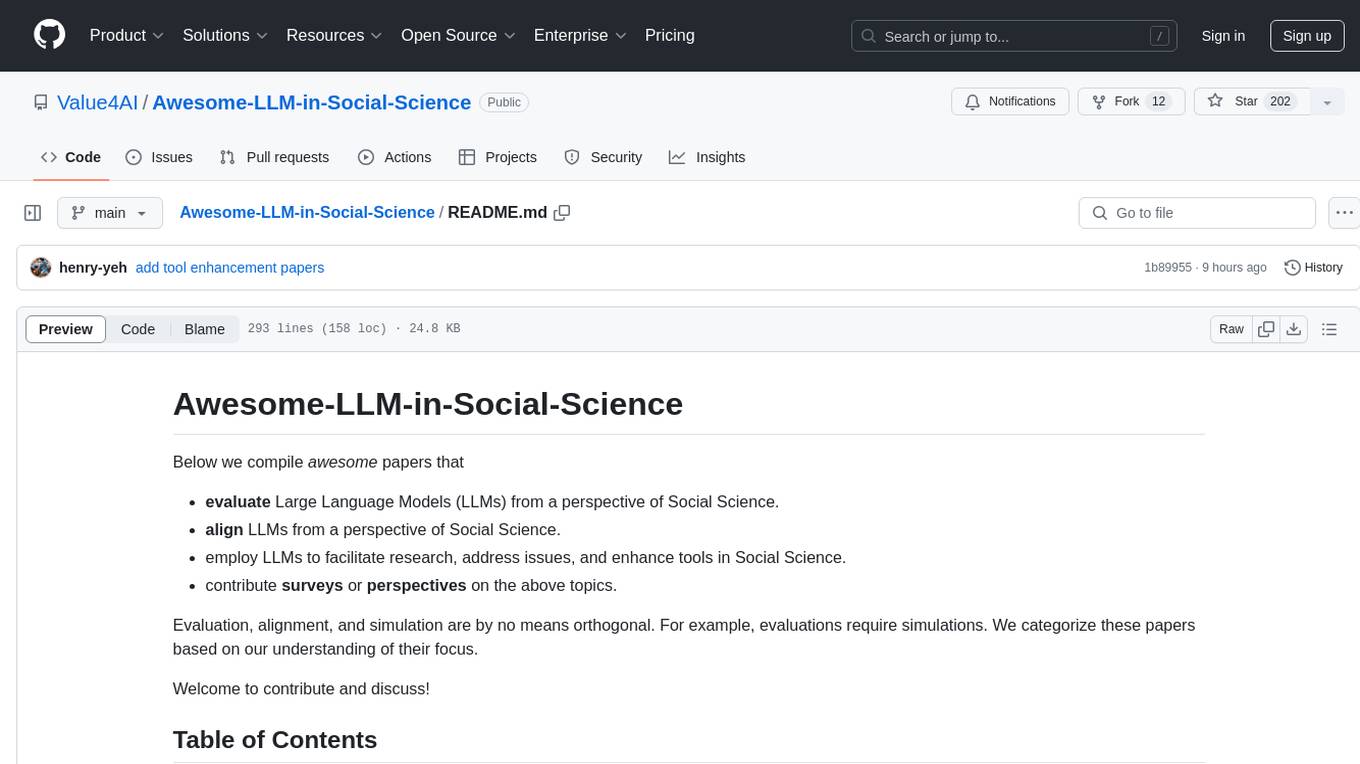
Awesome-LLM-in-Social-Science
Awesome-LLM-in-Social-Science is a repository that compiles papers evaluating Large Language Models (LLMs) from a social science perspective. It includes papers on evaluating, aligning, and simulating LLMs, as well as enhancing tools in social science research. The repository categorizes papers based on their focus on attitudes, opinions, values, personality, morality, and more. It aims to contribute to discussions on the potential and challenges of using LLMs in social science research.
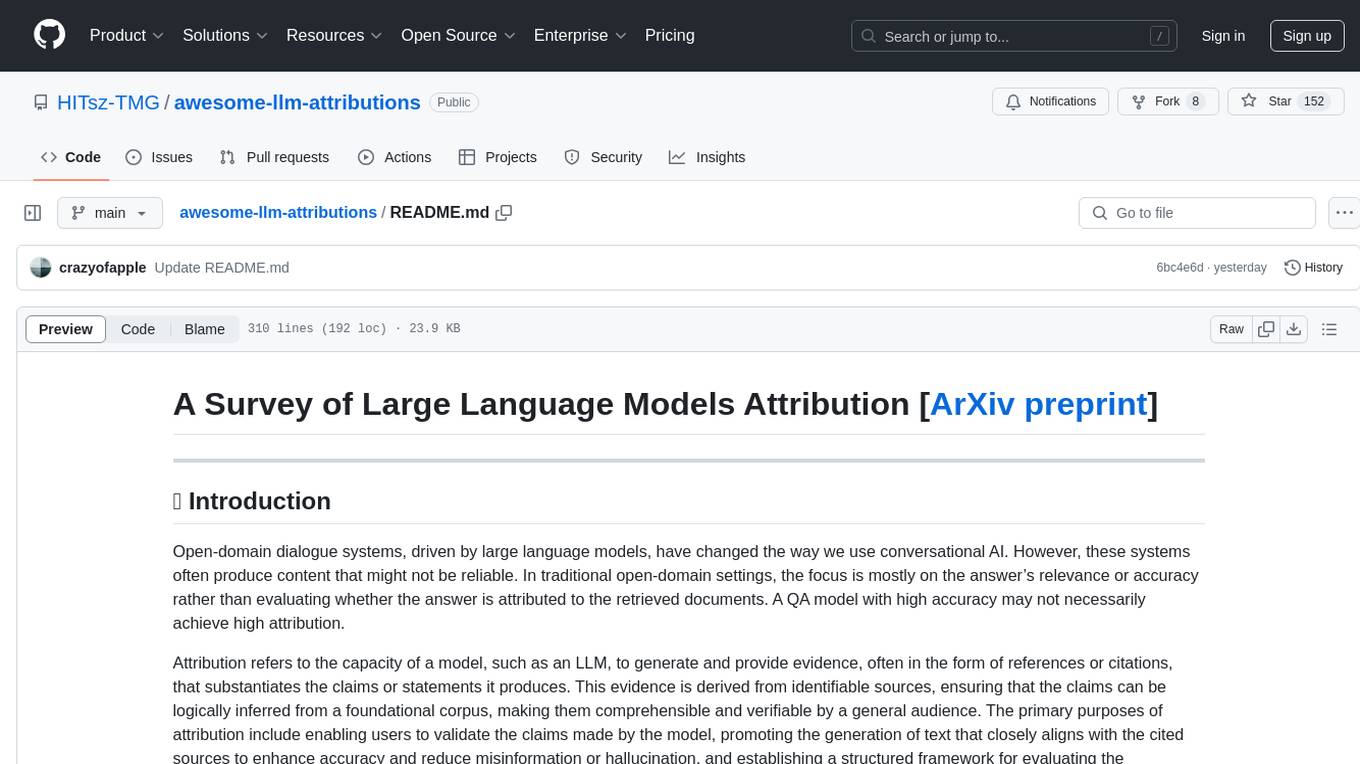
awesome-llm-attributions
This repository focuses on unraveling the sources that large language models tap into for attribution or citation. It delves into the origins of facts, their utilization by the models, the efficacy of attribution methodologies, and challenges tied to ambiguous knowledge reservoirs, biases, and pitfalls of excessive attribution.
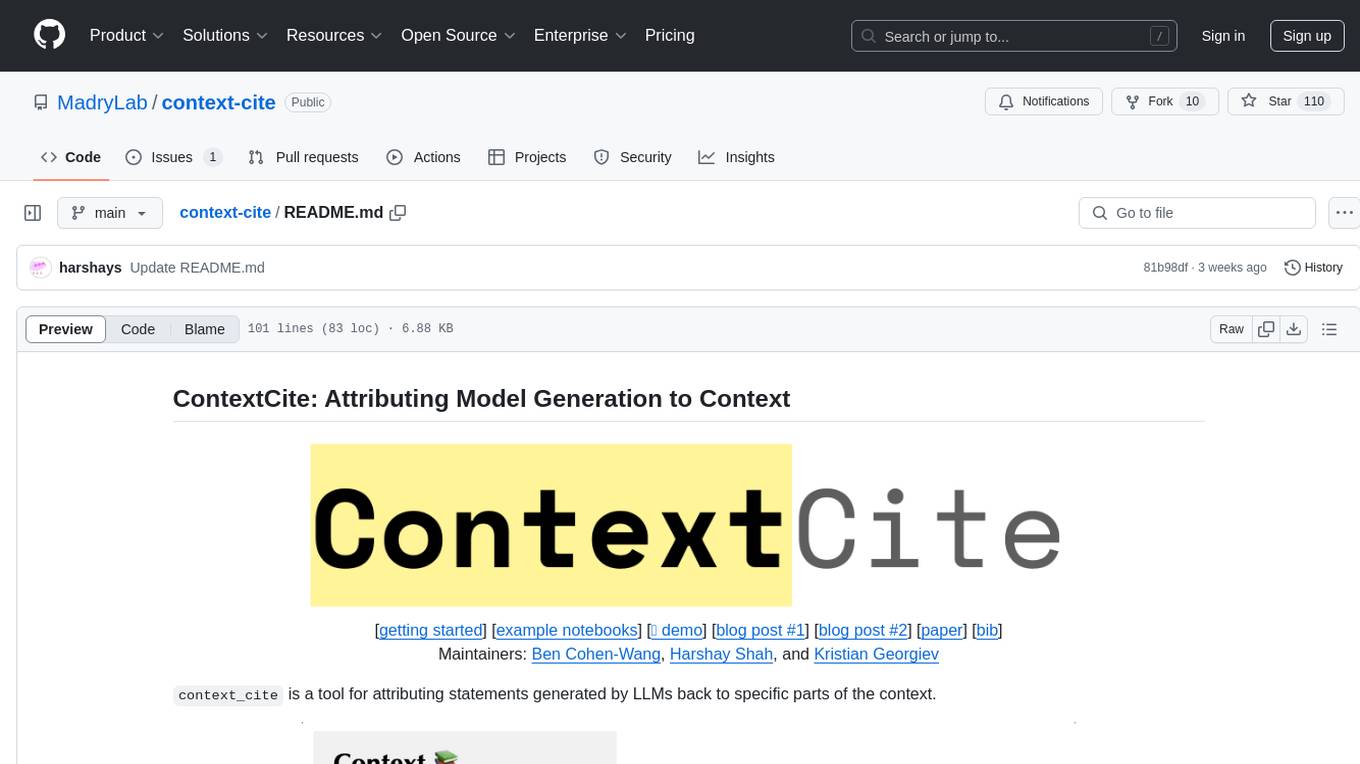
context-cite
ContextCite is a tool for attributing statements generated by LLMs back to specific parts of the context. It allows users to analyze and understand the sources of information used by language models in generating responses. By providing attributions, users can gain insights into how the model makes decisions and where the information comes from.
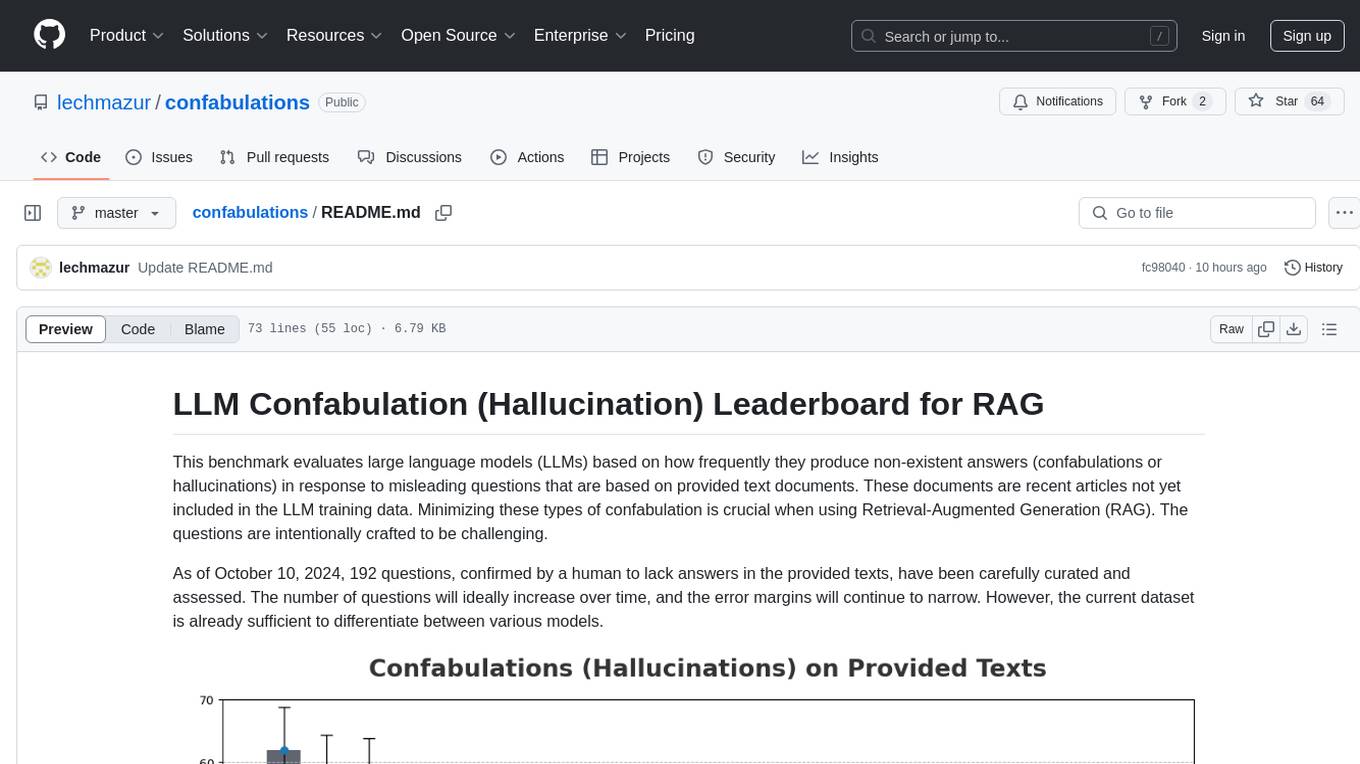
confabulations
LLM Confabulation Leaderboard evaluates large language models based on confabulations and non-response rates to challenging questions. It includes carefully curated questions with no answers in provided texts, aiming to differentiate between various models. The benchmark combines confabulation and non-response rates for comprehensive ranking, offering insights into model performance and tendencies. Additional notes highlight the meticulous human verification process, challenges faced by LLMs in generating valid responses, and the use of temperature settings. Updates and other benchmarks are also mentioned, providing a holistic view of the evaluation landscape.

